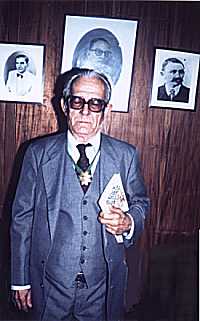CORDEL’S
STATUS THEN AND NOW
 Cordel
celebrates one hundred years of existence as we arrive at
the year 2000. The oldest
story-poems were printed in the 1890s, and the first major national event
registered in cordel was the War of Canudos in 1896, the national tragedy
when the Brazilian Army decimated the poor backlanders and their leader Antônio
Conselheiro in the backlands of Bahia. The
great pioneering poets of cordel, Leandro Gomes de Barros, Francisco das
Chagas Batista, João Melchíades Ferreira da Silva and others wrote in the
first decades of the century. João
Martins de Atayde then created the “heyday” of cordelian production with a
stable of writers in Recife, Pernambuco, from the late 1920s to the 1950s.
Atayde’s stock plus that of Leandro Gomes de Barros bought by
Atayde from the poet’s widow in 1921 were moved to Juazeiro do Norte,
Ceará, in the late 1950s when José Bernardo da Silva continued the tradition. So the city of Father Cícero also had its day in the sun.
Cordel
celebrates one hundred years of existence as we arrive at
the year 2000. The oldest
story-poems were printed in the 1890s, and the first major national event
registered in cordel was the War of Canudos in 1896, the national tragedy
when the Brazilian Army decimated the poor backlanders and their leader Antônio
Conselheiro in the backlands of Bahia. The
great pioneering poets of cordel, Leandro Gomes de Barros, Francisco das
Chagas Batista, João Melchíades Ferreira da Silva and others wrote in the
first decades of the century. João
Martins de Atayde then created the “heyday” of cordelian production with a
stable of writers in Recife, Pernambuco, from the late 1920s to the 1950s.
Atayde’s stock plus that of Leandro Gomes de Barros bought by
Atayde from the poet’s widow in 1921 were moved to Juazeiro do Norte,
Ceará, in the late 1950s when José Bernardo da Silva continued the tradition. So the city of Father Cícero also had its day in the sun.
Another generation continued
strong through the 1960s. Cordel
then began to diminish seriously because of the availability of the transistor
radio, then television, then color television, the high cost of producing
cordelian stories, and the lack of buying power by its traditional public.
Local fairs diminished and vanished, but mainly, Brazil modernized and cordel
no longer served as the main entertainment and news medium it was formerly for
the humble class of the Northeast.
But a mini-revival took place in
the 1970s and 1980s spurred on by intellectual interest when universities were
encouraged to have cordel represented in their curricula.
High school and grade school teachers were encouraged to teach cordel
so that young Brazilians would know of this important part of the national
heritage. An additional stimulus
for cordel was the sale of woodcuts alongside the cordelian stories in
the marketplaces with the result that even foreign tourists with little
knowledge of Portuguese could buy and take Northeastern folk art home in the
form of prints and folhetos de cordel.
The saga of the battle for a return to democracy after twenty-one years
of dictatorship, the “Direct Elections Campaign,” and the personal quest of
President-elect Tancredo Neves gave cordel a huge revival from 1983 to
1985. The return to democracy and
the usual jousting of presidential hopefuls kept things lively through the
election of Collor de Mello and his dramatic impeachment in the early 1990s.
Cordel continues
sporadically today but is a ghost of its former self. Some poets and woodcut artists hang on in both the Northeast
and the Northeastern Fair in Rio de Janeiro.
And there are middle-class aficionados who write in the cordelian
style in poems, short stories and novels; an enterprising few are even on the
internet!
But as we have said in previous
publications, whatever may be the main role of cordel today, one can be
grateful that it is preserved in the national archives as an important and
irreplaceable part of the national folk-popular heritage.
The Rui Barbosa Foundation in Rio de Janeiro, the Institute of Brazilian
Studies in São Paulo, the university collections in Paraíba, Ceará,
Pernambuco (and others) plus several private collections provide the greater
part of access to cordel today. A
recent and very ambitious program by Hedra Publishing House in São Paulo has
plans for fifty monographs on the best of cordelian poets by recognized scholars
in the field; may it come to fruition.
Cordel in the thousands
of poems in the archives is truly an encyclopedia in verse of a rich,
northeastern folk-literary past, of Brazilian social mores, and the minor and
major events of the twentieth century. Through
the poems ones sees “the vast unverse” of cordel. If one is industrious and persistent, he can still see
glimpses of that universe in Brazil today.